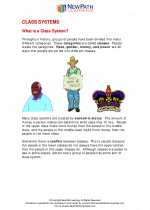History
History is the study of the past. It encompasses all human activities and events that have occurred up to the present. By studying history, we can understand how societies, cultures, and civilizations have developed and changed over time.
Why Study History?
Studying history is important for several reasons:
- Understanding the Present: History provides context for current events and helps us understand how the present has been shaped by the past.
- Learning from the Past: By studying historical events, we can learn from the successes and mistakes of previous generations.
- Cultural Awareness: History helps us appreciate the diversity of human cultures and understand the origins of different traditions and customs.
- Critical Thinking: Analyzing historical sources and interpretations encourages critical thinking and the ability to evaluate evidence.
Key Concepts in History
When studying history, it's important to be familiar with key concepts and terms. Some of these include:
- Chronology: The arrangement of events in the order in which they occurred.
- Primary Sources: Original documents or artifacts from a specific time period, such as letters, diaries, and photographs.
- Secondary Sources: Works that analyze and interpret primary sources, such as history books and scholarly articles.
- Cause and Effect: Understanding the reasons why historical events occur and the consequences they lead to.
- Historiography: The study of how history has been written and interpreted over time.
Study Guide
To effectively study history, consider the following tips:
- Develop Chronological Understanding: Create timelines to visualize the sequence of events and their relationships to one another.
- Analyze Primary Sources: Practice evaluating primary sources to understand the perspectives of people living in different historical periods.
- Compare Different Interpretations: Consider how historians have interpreted the same events in different ways, and analyze the reasons for these interpretations.
- Understand Historical Context: Explore the social, political, and cultural context in which historical events took place to gain a deeper understanding.
- Engage in Discussions: Discuss historical events and interpretations with classmates or teachers to gain new insights and perspectives.
[History] Related Worksheets and Study Guides:
.◂Social Studies Worksheets and Study Guides Sixth Grade. Class Systems
Study Guide Class Systems
Class Systems  Worksheet/Answer key
Worksheet/Answer key Class Systems
Class Systems  Worksheet/Answer key
Worksheet/Answer key Class Systems
Class Systems  Worksheet/Answer key
Worksheet/Answer key Class Systems
Class Systems 

 Worksheet/Answer key
Worksheet/Answer key
 Worksheet/Answer key
Worksheet/Answer key
 Worksheet/Answer key
Worksheet/Answer key

The resources above cover the following skills:
National Curriculum Standards for Social Studies (NCSS)
TIME, CONTINUITY, AND CHANGE
SOCIAL STUDIES PROGRAMS SHOULD INCLUDE EXPERIENCES THAT PROVIDE FOR THE STUDY OF THE PAST AND ITS LEGACY.
KNOWLEDGE - Learners will understand:
Concepts such as: chronology, causality, change, conflict, complexity, multiple perspectives, primary and secondary sources, and cause and effect.
INDIVIDUALS, GROUPS, AND INSTITUTIONS
SOCIAL STUDIES PROGRAMS SHOULD INCLUDE EXPERIENCES THAT PROVIDE FOR THE STUDY OF INTERACTIONS AMONG INDIVIDUALS, GROUPS, AND INSTITUTIONS.
KNOWLEDGE - Learners will understand:
Concepts such as: mores, norms, status, role, socialization, ethnocentrism, cultural diffusion, competition, cooperation, conflict, race, ethnicity, and gender.
National Standards for Civics and Government (NSCG)
What are the foundations of the American political system? What are the distinctive characteristics of American society?
Distinctive characteristics of American society. Students should be able to identify and explain the importance of historical experience and geographic, social, and economic factors that have helped to shape American society. To achieve this standard, students should be able to
Explain important factors that have helped shape American society
Social, economic, and geographic mobility
National Content Standards in Economics (NCSE)
Allocation
Students will understand that different methods can be used to allocate goods and services. People acting individually or collectively must choose which methods to use to allocate different kinds of goods and services. Students will be able to use this knowledge to evaluate different methods of allocating goods and services, by comparing the benefits to the costs of each method.
At the completion of Grade 8, students will know the Grade 4 benchmarks for this standard, and also that:
As consumers, people use resources in different ways to satisfy different wants. Productive resources can be used in different ways to produce different goods and services.
National Center for History in Schools (NCHS)
Historical Thinking Standards
Historical Comprehension
Reconstruct the literal meaning of a historical passage.
Historical Analysis and Interpretation
Compare and contrast differing sets of ideas.
Analyze cause-and-effect relationships and multiple causation, including the importance of the individual, the influence of ideas.
United States History Content Standards
Era 6: The Development of the Industrial United States (1870-1900)
How the rise of corporations, heavy industry, and mechanized farming transformed the American people.
The student understands the connections among industrialization, the advent of the modern corporation, and material well-being.
Massive immigration after 1870 and how new social patterns, conflicts, and ideas of national unity developed amid growing cultural diversity.
The student understands how new cultural movements at different social levels affected American life.
World History Content Standards
Era 5: Intensified Hemispheric Interactions 1000-1500 CE
The redefining of European society and culture, 1000-1300 CE.
The student understands feudalism and the growth of centralized monarchies and city-states in Europe.
The expansion of states and civilizations in the Americas, 1000-1500.
The student understands the development of complex societies and states in North America and Mesoamerica.
Era 7: An Age of Revolutions, 1750-1914
Patterns of nationalism, state-building, and social reform in Europe and the Americas, 1830-1914.
The student understands the political, economic, and social transformations in the Americas in the 19th century.
Patterns of global change in the era of Western military and economic domination, 1800-1914.
The student understands connections between major developments in science and technology and the growth of industrial economy and society.
Major global trends from 1750-1914.
The student understands major global trends from 1750 to 1914.
Era 8: A Half-Century of Crisis and Achievement, 1900-1945
Reform, revolution, and social change in the world economy of the early century.
The student understands the world industrial economy emerging in the early 20th century.